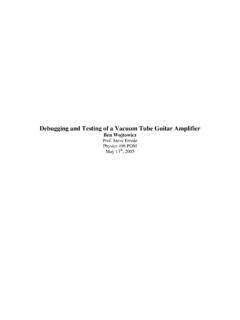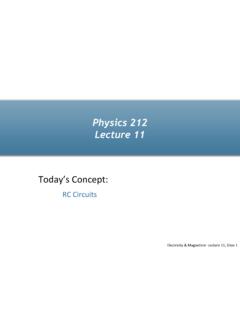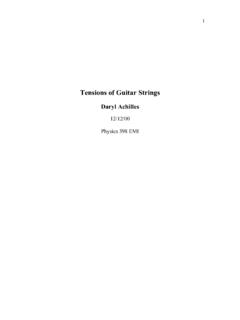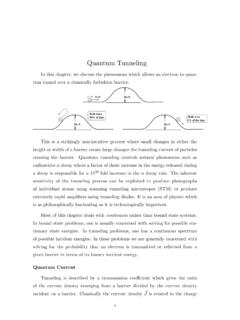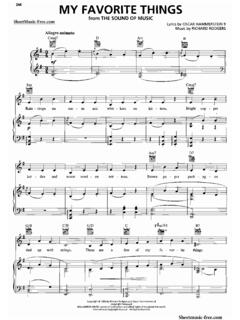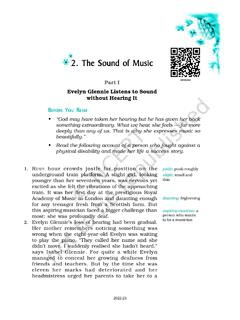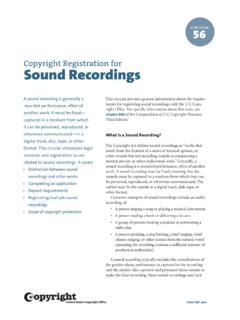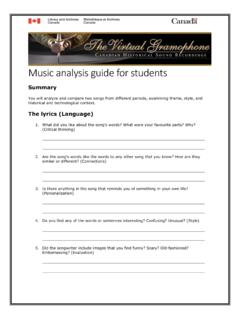Transcription of The Human Ear Hearing, Sound Intensity and Loudness Levels
1 UIUC Physics 406 Acoustical Physics of Music Professor Steven Errede, Department of Physics, University of Illinois at Urbana-Champaign, Illinois 2002 - 2017. All rights reserved. - 1 -The Human Ear Hearing, Sound Intensity and Loudness Levels We ve been discussing the generation of sounds, so now we ll discuss the perception of sounds. Human Senses: The astounding ~ 4 billion year evolution of living organisms on this planet, from the earliest single-cell life form(s) to the present day, with our current abilities to hear / see / smell / taste / feel / etc. all are the result of the evolutionary forces of nature associated with survival of the fittest it is evolutionarily{very} beneficial for us to be able to hear/perceive the natural sounds that do exist in the environment it helps us to locate/find food/keep from becoming food, etc., just as vision/sight enables us to perceive objects in our 3-D environment, the ability to move /locomote through the environment enhances our ability to find food/keep from becoming food; Our sense of balance, via a stereo-pair (!)
2 Of semi-circular canals (= inertial guidance system!) helps us respond to 3-D inertial forces ( gravity) and maintain our balance/avoid injury, etc. Our sense of taste & smell warn us of things that are bad to eat and/or Human Perception of Sound : * The Human ear responds to disturbances/temporal variations in pressure. Amazingly sensitive! It has more than 6 orders of magnitude in dynamic range of pressure sensitivity (12 orders of magnitude in Sound Intensity , I p2) and 3 orders of magnitude in frequency (20 Hz 20 KHz)! * Existence of 2 ears (stereo!) greatly enhances 3-D localization of sounds, and also the determination of pitch ( frequency resolution)! * Pinpoint accuracy for 3-D localization of sounds in the f 100 Hz ~ KHz range; good Sound localization accuracy up to ~ few KHz, and ~ reasonable, below ~ 100 Hz! * Mechanical & auditory sensory structure of ear preserves/is sensitive to/utilizes phase information over the f 100 Hz ~ KHz frequency range.
3 * Our brains process/use frequency/timing, amplitude/ Loudness and phase information in different frequency ranges for enhanced/improved localization of Sound The Human Ear has Three Basic Parts: * Outer Ear pinna - concentrates Sound waves into the ear canal (aka meatus) * Middle Ear eardrum (tympanium) transforms pressure variations into mechanical displacements (p = F/A); the ossicles (hammer, anvil, stirrup = malleus, incus, stapes) also mechanically amplify the sounds! * Inner Ear cochlea (& semi-circular canals for balance/orientation) hair cells convert pressure signals into neural signals, send them to various centers in brain for processing via auditory nerve(s) UIUC Physics 406 Acoustical Physics of Music Professor Steven Errede, Department of Physics, University of Illinois at Urbana-Champaign, Illinois 2002 - 2017. All rights reserved. - 2 - The Outer Ear: * Pinna (ear flap) concentrates/focuses Sound waves into ear canal.
4 * We used to have moveable ears (like donkeys), not much moveable, nowadays!!! * Ridges/ruffles in pinna unique to you (!) improves Sound localization at higher frequencies! UIUC Physics 406 Acoustical Physics of Music Professor Steven Errede, Department of Physics, University of Illinois at Urbana-Champaign, Illinois 2002 - 2017. All rights reserved. - 3 -* Auditory/ear canal is L ~ 3 cm long, closed at the inner ear at the eardrum a membrane. Auditoy canal = organ pipe (L ~ 3 cm long), with one end open and one end closed (Thus, there will be standing-wave resonances in the ear canal at:~4 , 1, 3, 5, Boosts our hearing sensitivity in the f ~ 2-5 KHz frequency range!!!). The Middle Ear: * Ossicular chain hammer, anvil, stirrup transmit Sound vibrations on ear drum to oval window of cochlea. Ossicles are a lever system, w/ ~ mechanical advantage. * Eardrum is ~ 20 bigger area than oval window gives overall amplification factor of ~ 26 !
5 * Performs important function of impedance-matching, efficiently transferring the mechanical vibrations of the ear drum/tympanium/tympanic membrane (~ low mechanical impedance) to the oval window (~ 20 higher mechanical impedance) and into cochlear fluid. mechZfFfvf , mechanical force Ff (Newtons) = pf A = pressure area. * The specific longitudinal acoustic impedance of cochlear fluid ~ that of sea water: 63~ 10--swacPa s mN s m . Note: 32--mechacZFv NsmNsmA m * Ossicles also protect the inner ear from very loud noises via the so-called acoustic reflex which triggers two sets of muscles one tightens the eardrum, another pulls the stirrup away from the oval window! * Also has a safety valve the eustachian tube - for pressure equalization and fluid drainage. The Inner Ear: * Cochlea coiled/rolled up (~ 2 turns), filled with perilymph fluid. * Cochlea is divided down its length by a soft partition known as the basilar membrane, forming 2 long chambers connected together by an opening at the far end called the helicotrema.
6 * ~ 15000 hair cells (connected to ~ 30,000 nerve fibers embedded in the basilar membrane) sense acoustic disturbances in perilymph fluid; transmit information to brain via the auditory nerve. * Amplitude of Sound waves in perilymph fluid reaches a maximum at a particular point along the cochlea, for a particular frequency! (see graph(s) ) * Sense of pitch ( Human perception of frequency) depends (in part) on location along the cochlea. * Additionally, 3 semi-circular canal(s) attached to cochlea = 3-axis (x, y, z) accelerometers (!) used for balance/orientation determination/sensing an inertial guidance system! UIUC Physics 406 Acoustical Physics of Music Professor Steven Errede, Department of Physics, University of Illinois at Urbana-Champaign, Illinois 2002 - 2017. All rights reserved. - 4 - Unrolled Human cochlea, and schematic of Sound pressure pulse propagating in perilymph fluid: Where frequencies of sounds peak along basilar membrane ( nonlinear relationship!)
7 : UIUC Physics 406 Acoustical Physics of Music Professor Steven Errede, Department of Physics, University of Illinois at Urbana-Champaign, Illinois 2002 - 2017. All rights reserved. - 5 - * The spiral shape of the cochlea enhances sensitivity to low frequency sounds by ~ 20 dB! Energy propagating in acoustic waves of perilymph fluid thus accumulates against the outside edge of the cochlear chamber. This effect is the strongest at the far end ( center) of cochlea where low frequency sounds are sensed. Analogous/related to the so-called whispering gallery mode effect whispers travel along the curved walls of a large chamber, and remain strong enough to be heard clearly on the opposite side of the room! D. Manoussaki, et al., Phys. Rev. Lett. 96, 088701 (2006). * Note that: 1020 10 logsdBG 10log20 102sG 210100sG . 20 dB corresponds to a signal gain 100soutinGSS in the low frequency region!!! UIUC Physics 406 Acoustical Physics of Music Professor Steven Errede, Department of Physics, University of Illinois at Urbana-Champaign, Illinois 2002 - 2017.
8 All rights reserved. - 6 -Cross-Sectional/Cut-Away View of One Portion of the Human Cochlea: The Human ear has two rows of hair cells in the Organ of Corti, which generate electrical signals in response to pressure signals in the perilymph fluid along the basilar membrane. The primary function of the inner row of ~ 4000 hair cells is to generate the electrical signals sent to the brain via the auditory nerve. The outer triple-row of ~ 12,000 chevron-shaped hair cells function as biological amplifiers, boosting the sensitivity level of the Human ear by ~ 40 dB! Note that: 1040 10 logsdBG 10log40 104sG 41010, 000sG . 40 dB corresponds to a signal gain 10, 000soutinGSS !!! Organ of Corti Auditory Nerve Basilar Membrane UIUC Physics 406 Acoustical Physics of Music Professor Steven Errede, Department of Physics, University of Illinois at Urbana-Champaign, Illinois 2002 - 2017. All rights reserved. - 7 - Colored electron micrograph of the Organ of Corti: UIUC Physics 406 Acoustical Physics of Music Professor Steven Errede, Department of Physics, University of Illinois at Urbana-Champaign, Illinois 2002 - 2017.
9 All rights reserved. - 8 -Inner and Outer Hair Cells in the Organ of Corti of the Human Ear: Each hair cell has many hairs (stereocilia) that are bent/vibrated when the basilar membrane responds to Sound waves in the perilymph fluid. The bending of the stereocilia stimulates the hair cells, which in turn excite neurons in the auditory nerve. The neuron firing/impulse rate on the auditory nerve depends on both the Sound Intensity I and the frequency f of the Sound neurons do not fire on every oscillation cycle of frequency f for very faint sounds. Neutrons do tend to fire on the peaks of/in phase with a cycle, however. Individual Stereocilia UIUC Physics 406 Acoustical Physics of Music Professor Steven Errede, Department of Physics, University of Illinois at Urbana-Champaign, Illinois 2002 - 2017. All rights reserved. - 9 -Inner Hair Cells: Outer Hair Cells: Synapse Afferent Efferent UIUC Physics 406 Acoustical Physics of Music Professor Steven Errede, Department of Physics, University of Illinois at Urbana-Champaign, Illinois 2002 - 2017.
10 All rights reserved. - 10 -Action of an Inner Hair Cell: Function of a Stereocilia: An auditory Sound vibration / stimulation of stereocilia in a hair cell causes the release of a neuro-transmitter (TRPA1 protein see below) which in turn stimulates a neuron in the auditory nerve. TRPA1 Structural Model: VViibbrraattiioonn )))))))) NNeeuurroottrraannssmmiitttteerr rreelleeaasseedd HHaaiirr CCeellll NNeerrvvee HHaaiirr CCeellll DDeeppoollaarriizzeess UIUC Physics 406 Acoustical Physics of Music Professor Steven Errede, Department of Physics, University of Illinois at Urbana-Champaign, Illinois 2002 - 2017. All rights reserved. - 11 -Firing of Auditory Nerve Fibers: ~ 95% of the auditory nerve fibers (type I) are connected to the ~ 4000 inner hair cells. Each type I axon innervates only a single hair cell, but each hair cell directs it output up to ~ 10 type I auditory nerve fibers. The type I auditory nerve fibers are bipolar and are mylenated ( have a nerve sheath this protects the nerve fiber and also increases the transmission speed of action potentials along nerve fiber by up to ~ 300 over non-mylenated nerves evolutionarily very important for our auditory startle reflex!



